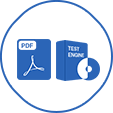Last Update 4 hours ago Total Questions : 60
The SAP Certified Specialist - Implementation Consultant - SAP S/4HANA Cloud Private Edition content is now fully updated, with all current exam questions added 4 hours ago. Deciding to include E_S4CPE_2405 practice exam questions in your study plan goes far beyond basic test preparation.
You'll find that our E_S4CPE_2405 exam questions frequently feature detailed scenarios and practical problem-solving exercises that directly mirror industry challenges. Engaging with these E_S4CPE_2405 sample sets allows you to effectively manage your time and pace yourself, giving you the ability to finish any SAP Certified Specialist - Implementation Consultant - SAP S/4HANA Cloud Private Edition practice test comfortably within the allotted time.
Which technologies should you use to integrate SAP S/4HANA Cloud Private Edition with an SAP public cloud solution? Note: There are 2 correct answers to this question.
Where is the initial list of known integrations documented?
What are some prerequisites if you want to transfer data with the Migrate Your Data - Migration Cockpit app using a separate SAP HANA database in SAP S/4HANA Cloud Private Edition?
Note: There are 2 correct answers to this question.
You are designing side-by-side extensions in the customer's SAP BTP system. Which extensions can you use?
Note: There are 2 correct answers to this question.
Where do you identify new and changed features in the latest release of SAP S/4HANA? Note: There are 2 correct answers to this question.
In which phase of an implementation project do the Fit-to-Standard analysis and design workshops take place?
When do you specify the data retention period in the SAP S/4HANA Migration Cockpit?

